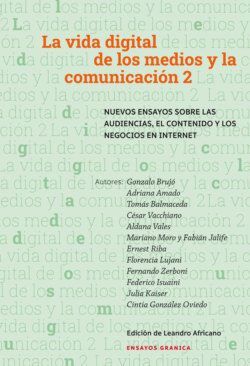Читать книгу Vida digital de los medios y la comunicación 2 - Adriana Amado - Страница 20
Bibliografía
ОглавлениеAmado, A. (2019). Comunicación pública y medios de comunicación social. En H. Guzmán Ramírez y R. Herrera Echenique (Eds.), Comunicación estratégica: interfaz entre organizaciones y sus Stakeholders (pp. 241–264). Fondo de Publicaciones Universidad Sergio Arboleda.
Amado, A. (2021). Las metáforas del periodismo: guía para periodistas mutantes. Ampersand.
Ariely, D. (2013). Las trampas del deseo: Cómo controlar los impulsos irracionales que nos llevan al error. Ariel.
Ballerini, M., Cabibbo, N., Candelier, R., Cavagna, A., Cisbani, E., Giardina, I., Lecomte, V., Orlandi, A., Parisi, G., Procaccini, A., Viale, M., & Zdravkovic, V. (2008). Interaction ruling animal collective behavior depends on topological rather than metric distance: Evidence from a field study. Proceedings of the National Academy of Sciences of the United States of America, 105(4), 1232–1237. https://doi.org/10.1073/pnas.0711437105
Barthes, R. (1993). La aventura semiológica. Paidós.
Bennett, W. L., & Iyengar, S. (2008). A New Era of Minimal Effects? The Changing Foundations of Political Communication. Journal of Communication, 58(4), 707–731. https://doi.org/10.1111/j.1460-2466.2008.00410.x
Berger, J. (2016). Invisible Influence. The Hidden Forces that Shape Behavior. Simon & Schuster.
Brennen, A. J. S., Simon, F. M., Howard, P. N., & Nielsen, R. K. (2020). Types, Sources, and Claims of COVID-19 Misinformation. En Oxford Internet Institute (Issue April).
Broockman, D. E., & Green, D. P. (2014). Do Online Advertisements Increase Political Candidates’ Name Recognition or Favorability? Evidence from Randomized Field Experiments. Political Behavior, 36(2), 263–289. https://doi.org/10.1007/s11109-013-9239-z
Davies, N. (2008). Flat Earth News. Chatto & Windus.
Eco, U. (1986). La estrategia de la ilusión. Lumen.
Fletcher, R., Cornia, A., Graves, L., & Nielsen, R. K. (2018). Measuring the reach of “fake news” and online disinformation in Europe. https://reutersinstitute.politics.ox.ac.uk/our-research/measuring-reach-fake-news-and-online-disinformation-europe
Guess, A., Montgomery, J. M., Lyons, B., Nyhan, B., & Reifler, J. (2019). Fake news, Facebook ads, and misperceptions. Assessing information quality in the 2018 U. S. midterm election campaign.
Kalla, J. L., & Broockman, D. E. (2017). The Minimal Persuasive Effects of Campaign Contact in General Elections: Evidence from 49 Field Experiments. American Political Science Review, 1–19. https://doi.org/10.1017/S0003055417000363
Karpf, D. (2019). On Digital Disinformation and Democratic Myths. MediaWell. https://mediawell.ssrc.org/expert-reflections/on-digital-disinformation-and-democratic-myths/
Klein, N. (2001). No logo. Paidós.
Lash, S. (2005). Crítica de la información. Amorrortu.
Lash, S., & Lury, C. (2007). Global Culture Industry. Polity Press.
McIntyre, L. (2018). Posverdad. Cátedra.
Muraro, H. (1987). Invasión cultural, economía y comunicación. Legasa.
Ortiz, R. (2000). Modernidad y espacio. Norma.
Rubio Núñez, R. (2018). Los efectos de la posverdad en la democracia // The effects of post-truth politics on democracy. En Revista de Derecho Político (Vol. 1, Issue 103). https://doi.org/10.5944/rdp.103.2018.23201
Salmon, C. (2008). Storytelling: la máquina de fabricar historias y formatear las mentes. Península.
Tucker, J., Guess, A., Barberá, P., Vaccari, C., Siegel, A., Nyhan, B., Sanovich, S., & Stukal, D. (2018). Social Media, Political Polarization, and Political Disinformation: A Review of the Scientific Literature 1 (Issue March). https://doi.org/http://dx.doi.org/10.2139/ssrn.3144139
Verón, E. (2001). Espacios mentales. Gedisa.
Waisbord, S. (2018). Truth is What Happens to News. Journalism Studies, 0(0), 1–13. https://doi.org/10.1080/1461670X.2018.1492881
32. https://ico.org.uk/about-the-ico/news-and-events/news-and-blogs/2020/10/blog-the-conclusion-of-the-ico-s-investigation-into-the-use-of-personal-data-in-political-campaigning/
